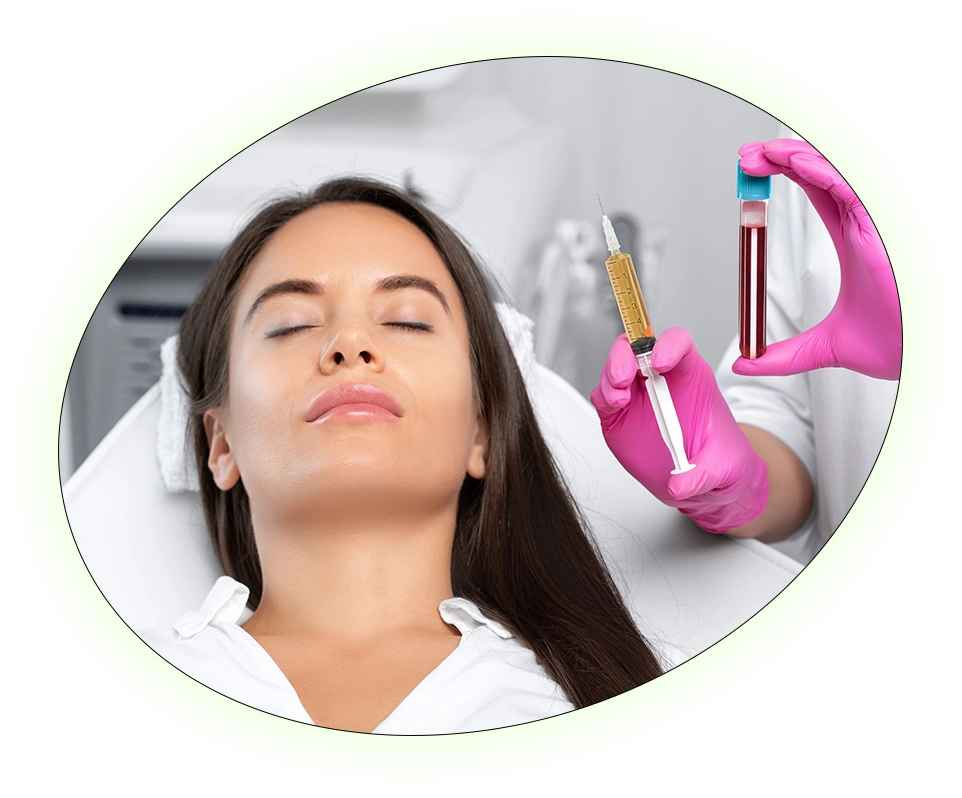What It Is & Uses
What Is PRP Therapy?
Platelet-rich plasma (PRP) therapy is a regenerative treatment that uses a concentrated form of a patient’s own platelets to stimulate healing. Platelets contain essential growth factors that support tissue repair, making PRP an effective option for musculoskeletal injuries, arthritis, and even cosmetic rejuvenation.

PRP therapy enhances the body’s natural healing response by delivering a high concentration of platelets directly to the affected area. These platelets release growth factors that promote cell regeneration, reduce inflammation, and accelerate tissue repair.
The procedure starts with drawing a small amount of the patient’s blood. This blood sample is then placed in a centrifuge, a machine that spins at high speeds to separate platelets from other blood components like red and white blood cells.
Once the platelets are concentrated, the PRP is carefully injected into the injured or affected area. This targeted application allows for enhanced healing in joints, tendons, ligaments, and even skin, depending on the treatment’s purpose.
PRP is widely used in orthopedics for conditions such as arthritis, tendon injuries, and ligament damage. It is also gaining popularity in the cosmetic industry for skin rejuvenation and hair restoration, helping to promote a youthful and refreshed appearance.
PRP therapy is a minimally invasive option for those looking to enhance healing naturally. While many patients experience significant benefits, results may vary. Consulting with a specialist can help determine if PRP is the right treatment for your specific condition.
Platelet-rich plasma (PRP) therapy is a regenerative treatment that uses a patient’s own concentrated platelets to enhance healing and tissue repair. The process involves drawing blood, separating the platelets using a centrifuge, and injecting the PRP into the affected area. PRP is commonly used to treat musculoskeletal injuries, arthritis, and ligament damage, as well as for cosmetic rejuvenation, including skin and hair treatments.
If you’re interested in exploring regenerative medicine for your herniated disc, we’re here to help. Our team of specialists can provide personalized advice and discuss available treatment options.
Discover how PRP therapy, BMAC therapy and Stem Cell therapy can transform spinal care. Explore the benefits, recovery process, and long-term advantages of this innovative treatment. Ready to learn more? Let’s dive in!
Here are some of the questions that we are asked most frequently at Total Spine and Wellness
Regenerative medicine aims to replace damaged tissue or organs caused by factors like age, disease, trauma, or congenital issues, as opposed to focusing solely on symptom management. This is achieved through the use of tissue engineering, cellular therapies, medical devices, and artificial organs.
By combining these approaches, we can enhance our body’s natural healing process where it is most needed. Regenerative medicine brings together experts from various specialties who wish to be on the cutting edge of medicine.
When our bodies are injured or affected by disease, they possess an innate ability to heal and defend themselves. What if we could harness this inherent power and accelerate the healing process in a clinically relevant manner? What if we could aid the body in healing more effectively?
The promising field of regenerative medicine strives to restore the structure and function of damaged tissues and organs. It also aims to develop solutions for organs that have sustained permanent damage. Ultimately, the goal of regenerative medicine is to create transformative healthcare solutions that could potentially help injuries and diseases that were previously deemed untreatable.
Stem cells have the remarkable ability to develop into different cell types in the body and can also repair damaged tissues. When introduced into a specific area, they can promote healing through various mechanisms. Stem cells can differentiate into the desired cell type, replacing damaged cells directly. They can also secrete growth factors and proteins that stimulate the surrounding cells to regenerate and repair themselves. Additionally, stem cells can modulate the immune response and reduce inflammation, creating a more favorable environment for healing. These combined effects make stem cells a valuable tool for treating degenerative conditions.
These surgical procedures are considered part of a physician’s practice of medicine, allowing both the physician and patient to freely consider their preferred treatment options. While the FDA does provide guidelines for the treatment and manipulation of a patient’s own tissues, Total Spine adheres to these guidelines by offering same-day treatment using the patient’s unaltered cells, which are inserted during the procedure.
We use all autologous cells (the patients own cells). We utilize bone marrow stem cells and Stromal cells (from adipose). Each person will be evaluated individually before a specific treatment modality is suggested.
Stem cells are undifferentiated cells in our bodies that have the remarkable ability to develop into various types of specialized cells. They can divide and renew themselves to form more stem cells or differentiate into specific cell types, such as muscle, nerve, or blood cells. Stem cells play a crucial role in the development, growth, and repair of tissues and organs in our bodies. They hold great potential for medical research and regenerative medicine, as they may be used to treat a wide range of diseases and injuries.
Mesenchymal stem cells (MSCs) are a promising source for the treatment of OA due to their multipotency for differentiation into chondrocytes and their ability to modulate the immune system.
Not everyone is a good candidate for stem cell treatment. We offer a complimentary consultation and imaging review to determine if someone is likely to benefit from our treatments. If the severity of the condition is too great and a successful outcome is not likely, the patient will be told that in consultation.
Not everyone is a good candidate for stem cell treatment. We offer a complimentary consultation and imaging review to determine if someone is likely to benefit from our treatments. If the severity of the condition is too great and a successful outcome is not likely, the patient will be told that in consultation.
We are a team of highly specialized spine surgeons dedicated to pioneering the future of spine care.